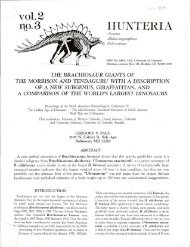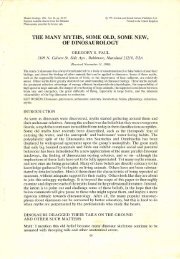Dinosaur models: the good, the bad, and using - Gregory S. Paul
Dinosaur models: the good, the bad, and using - Gregory S. Paul
Dinosaur models: the good, the bad, and using - Gregory S. Paul
You also want an ePaper? Increase the reach of your titles
YUMPU automatically turns print PDFs into web optimized ePapers that Google loves.
FIGURE7-Front view of 6 tonne Triceratops fitted onto a large Ceratopsipes<br />
trackway. Note that although <strong>the</strong> chest ribs are narrow, <strong>and</strong><br />
<strong>the</strong> foreprints are wider gauge than <strong>the</strong> larger hindprints, forelimb posture<br />
is erect. On <strong>the</strong> lower left are very large trackways that may have<br />
been made by oversized ceratopsids. Scale bar equals 1 m.<br />
than <strong>the</strong> front end of <strong>the</strong> hips. The hips become broader progressing<br />
backwards, <strong>the</strong> reverse of <strong>the</strong> usual condition. It is extremely<br />
peculiar that <strong>the</strong> transverse processes at <strong>the</strong> base of <strong>the</strong><br />
tail are so long that <strong>the</strong>y form a set of functional ribs behind <strong>the</strong><br />
pelvis. The false ribs' slenderness <strong>and</strong> dorsally convex are, <strong>the</strong><br />
posteriorly broad hips, <strong>and</strong> <strong>the</strong> absence of chevrons from <strong>the</strong> tail<br />
base suggest that <strong>the</strong>re was a large extension of <strong>the</strong> digestive<br />
tract behind <strong>the</strong> hips, a rarity among vertebrates.<br />
Iguanodonts <strong>and</strong> Hadrosaurs, Sometimes Bigger Than You<br />
Think<br />
Big ornithopod heads <strong>and</strong> necks were moderate in size, bodies<br />
were compact <strong>and</strong> somewhat slab sided (except camptosaurs),<br />
tails were moderate in size, <strong>and</strong> hindlegs were long <strong>and</strong> powerfully<br />
muscled in <strong>the</strong>se running forms. In some iguanodonts,<br />
Dinofest.® International Proceedings<br />
139<br />
<strong>and</strong> all hadrosaurs, <strong>the</strong> front half of <strong>the</strong> trunk was strongly downarched<br />
(<strong>Paul</strong>, 1987), which dramatically shortened <strong>the</strong> trunk <strong>and</strong><br />
reduced its volume. If ungulate-like nuchal tendons helped support<br />
<strong>the</strong> head <strong>and</strong> neck in tall spined iguanodonts <strong>and</strong> in hadrosaurs<br />
(Czerkas, 1993) <strong>the</strong>y were narrow <strong>and</strong> had little influence<br />
on mass. The belly was extremely deep in some iguanodonts,<br />
<strong>and</strong> <strong>the</strong> deep tails were very compressed from side to<br />
side. Although <strong>the</strong> arms were long, <strong>the</strong>y were slender <strong>and</strong> had<br />
little influence upon overall mass.<br />
Plump Camptosaurus seems a modest sized dinosaur because<br />
many skeletons are juvenile, but some individuals approached 2<br />
tonnes (Erickson, 1988). Large Iguanodon exceeded 3 tonnes,<br />
higher values in Colbert (1962) <strong>and</strong> Alex<strong>and</strong>er (1989) are based<br />
on inaccurate <strong>models</strong>. Also excessive, <strong>and</strong> often inconsistent, are<br />
mass estimates for typical American hadrosaurs as high as 4<br />
tonnes. Colbert estimated that <strong>the</strong> New York Corythosaurus was<br />
heavier than <strong>the</strong> Anatotitan in <strong>the</strong> same hall, yet visual comparison<br />
on site shows that <strong>the</strong> latter is <strong>the</strong> bigger of <strong>the</strong> two specimens<br />
(AppendFigs. 7,8). Most American examples weighed<br />
about 2.5-3.0 or more tonnes (<strong>the</strong> 2.2 tonne estimate by Bel<strong>and</strong><br />
& Russell [1978] differs only in that <strong>the</strong>ir <strong>models</strong> were too hollow<br />
bellied). These masses are comparable to big white rhino<br />
bulls (AppendFig. 6-8), although <strong>the</strong> hadrosaurs tend to look<br />
larger because of <strong>the</strong>ir deeper body profile, large but thin tails,<br />
<strong>and</strong> taller stature. Hadrosaurs are unusually uniform <strong>and</strong> isometric<br />
in body design <strong>and</strong> proportions regardless of size, <strong>and</strong><br />
some were surprisingly big. Some American hadrosaurs are two<br />
thirds or more longer than <strong>the</strong> norm (Morris, 1972) <strong>and</strong> suggest<br />
individuals of around 13 tonnes. Asian Shantungosaurus is modeled<br />
at 10-13 tonnes. The biggest hadrosaur trackways (Lockley<br />
et al., 1983) record individuals with feet about twice as large as<br />
those of typical examples, <strong>and</strong> imply weights as high as 20 to<br />
25 tonnes, World record individuals approaching or exceeding<br />
30 tonnes are probable. Giant hadrosaurs greatly outweighed<br />
ceratopsids, at least matched <strong>the</strong> biggest l<strong>and</strong> mammals, <strong>and</strong><br />
rivaled many sauropods-quite a feat for animals that bore most<br />
of <strong>the</strong>ir mass on two legs. Hadrosaurs were longer limbed than<br />
sauropods. Example: Shantungosaurus hindlegs were about as<br />
long as those of Apatosaurus, but <strong>the</strong> latter was about a third<br />
heavier.<br />
Some Very Large Footprints<br />
The 1.3 m long Jurassic Gigantosauropus footprints are <strong>the</strong><br />
largest yet discovered (Mensink & Mertmann, 1984). They are<br />
so enormous, <strong>and</strong> ill defined in shape, that <strong>the</strong>y are difficult to<br />
accept at face value. However, <strong>the</strong>y do not show clear signs of<br />
distortion, <strong>and</strong> appear to represent a three toed biped of 20 to<br />
30 tonnes <strong>and</strong> over 15 m length. No <strong>the</strong>ropod is known to have<br />
reached more than a third of this bulk, such masses <strong>and</strong> dimensions<br />
are approached by some ornithopods skeletons <strong>and</strong> prints,<br />
<strong>and</strong> <strong>the</strong> prints' short, broad toes are most like those of ornithopods.<br />
MASSIVE MISTAKES AND REVELATIONS<br />
Many studies of dinosaur biology depend upon accurate mass<br />
estimates. Some examples of how mass estimates incorrect <strong>and</strong><br />
correct can lead to results errant <strong>and</strong> useful are detailed below.<br />
Rocking, Stomping <strong>Dinosaur</strong>s<br />
Alex<strong>and</strong>er (1989) used <strong>the</strong> inaccurate BMNH commercial<br />
<strong>models</strong> to measure <strong>the</strong> fore-<strong>and</strong>-aft mass distribution of dinosaurs.<br />
More accurate <strong>models</strong> would give better results, but <strong>the</strong>re<br />
will always be a high degree of uncertainty because it is not<br />
possible to precisely restore <strong>the</strong> internal distribution (especially<br />
internal air-spaces) of mass in extinct forms. Just a modest error









